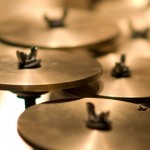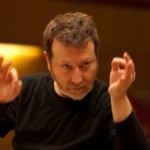It hardly needs to be said that contemporary music enjoys a privileged status in Germany. Even with the heavily protested merger of the SWR (Southwest German Radio) Orchestras currently in effect, the support of public broadcasting for cutting-edge programming everywhere from Donaueschingen to ‘poor but sexy’ Berlin creates an atmosphere of seemingly boundless experimentation. The annual Ultraschall Festival, co-presented by Berlin’s two major classical radio stations, Deutschlandradio and Kulturradio RBB, sets out to provide a glimpse into the wide spectrum of developments, consciously elevating adventure above dramaturgical unity.
The event, whose moderated concerts often strike a decidedly academic tone, moved into clubs for the first time this year, hosting the Ensemble Modern at the FritzClub on January 24. Despite the dark, underground aesthetic of the brick-walled space, the atmosphere departed little from that of a traditional concert save for the occasional clink of a wine glass. Most of the audience sat nearly motionless in rapt attention. The turn-out was also not particularly young, debunking theories that orchestras’ core subscribers have an aversion to anything after Stravinsky. But then again, this is Berlin.
The evening included the German premiere of Warm-up for horn and percussion by Vito Žuraj, one of many successful Wolfgang Rihm students on the scene. The work had its world premiere for the composer’s 60th birthday in Ljubljana last year and, true to its title, is intended as a prelude to Žuraj’s Horn Concerto which will have its premiere in 2014 under the baton of Matthias Pintscher. Žuraj exploits a breadth of muted, often ghostly timbres on the solo instrument to expressive effect, underscored by whirring, overlapping percussion rhythms that require coordination by a conductor (Erik Charles Nielsen). Hornist Saar Berger, with whom the composer collaborated in writing the piece, imbued every attack and line with meaning.
The solo flute work Aura by the late Emmanuel Nunes, here performed by Dietmar Wiesner, is a more introspective soliloquy but similarly exploits extreme ranges of the instrument, from fluttering to abrasive lip stops, while following a limited harmonic scheme. The most gripping work of the evening for this listener was the solo piano work Kaspars Tanz by Hanspeter Kyburz, a reflection on the life of Kaspar Hauser, an 19th century legend whose tragic existence following his upbringing in a cell has inspired poetry, opera and film. The composer juxtaposes exultant runs of freedom with dark clusters evoking his isolation, achieving a structured outpouring of emotion. Ueli Wiget brought the drama to life through an energetic, insightful performance.
An important tenet of Ultraschall is also the championing of young composers. In tribute to this year’s focus on Franco-German exchange, a concert at the Volksbühne at Rosa-Luxemburg Platz on January 24 featured the ensemble mosaik in winning compositions from a competition launched by the Lyon-based initiative ‘New Forum—Jeune Création.’ Inventive uses of live and electronic sound ranged from Christopher Trapani’s dreamscape of samples and lyrical textures in Five out of Six, set to conceptual video by Things Happen, to the alternation of a visceral, techno-derived pulse and a violin-cello duo that desperately bowed to the same heartbeat-like rhythm in Aurélio Edler-Copes’ For Malevich.
The star of the evening from the audience’s view and in terms of pure shock value was Johannes Kreidler. The young German composer, winner of last year’s coveted Kranichsteiner Prize, has earned the standing of an ‘Aktionskünstler,’ making headlines in The New Yorker when he smashed a pair of model string instruments in protest against the merger of the SWR orchestras last fall. His work Fremdarbeit¸ originally performed in 2009 at Klangwerkstatt Berlin, sets out to take issue with exploitation and copyright in a globalized, digital age. The composer commissioned a Chinese composer and Indian programmer to remix, or ‘plagiarize,’ his pre-existing composition windowed 1 that itself integrates samples.
The composer moderates the work with a mix of cutting social criticism and detached irony. ‘Most of Xiang’s music is commissioned for weddings and funerals by U.S.-Americans,’ he says. ‘But he agreed to this for $30.’ The result of programmer Murrabay’s computer manipulation yields a pointillist version out of which he provided Kreidler with an exact break-down of volume ratios and musical patterns. It is impossible to restrain laughs when the composer narrates this back to the audience in utter seriousness, although one can’t help but wonder to what extent Kreidler is unaware of the exploitation in which he is himself indulging. His activism stays as close to the surface as the saccharine pop music he quotes, an illusion of human progress that is ultimately absorbed in its own vain post-modernist conquest.

